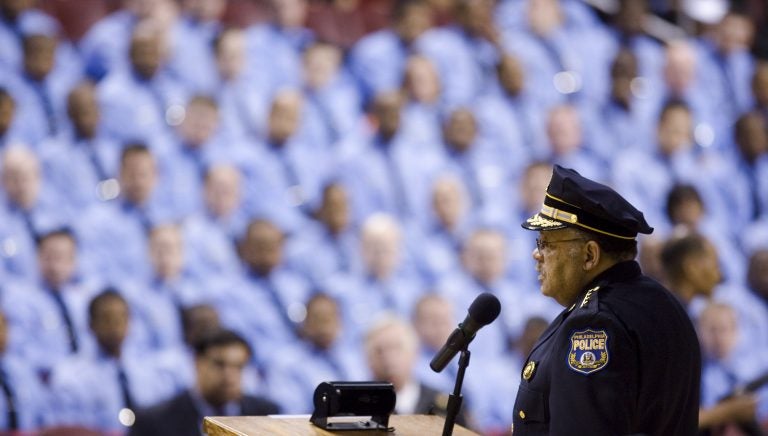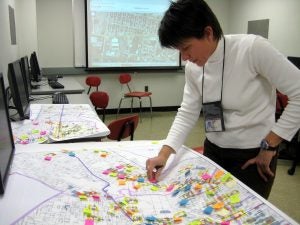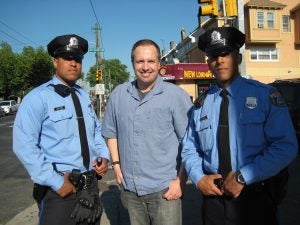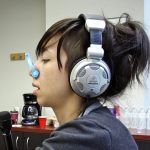The police experiment that changed what we know about foot patrol
What works in policing high-crime areas, and what doesn't?
Listen 12:06
Philadelphia Police Commissioner Charles Ramsey addresses the city's sworn and civilian personnel on his new crime-fighting strategy, he wants to move more officers into high crime areas. (Matt Rourke/ AP Photo)
This story is from The Pulse, a weekly health and science podcast.
Subscribe on Apple Podcasts, Stitcher or wherever you get your podcasts.
Sgt. Bill Robbins gestured outside the window of his police cruiser as we drove through the gray, autumn streets of West Philadelphia.
“Now this is our 60th Street corridor,” Robbins said, as he made a turn. “This is like our hot spot. We get a lot of problems.”
“Hot spot” is a criminology term that refers to a high-crime area. And in Philadelphia — which consistently ranks above the national average when it comes to violent crime — there are plenty.
“This bar here, this can sometimes be a nuisance bar,” Robbins said, pointing out the windshield.
Across the street was another problem corner.
“Right where the guy’s standing at, they sell narcotics in front of that house there,” he said. “We get shootings on that block.”
In decades past, the Philadelphia Police Department dealt with high-crime areas in much the same way as the rest of the city — through preventive patrol, which relies on officers covering wide swaths of territory in their cars.
That changed in 2008, when Philadelphia’s then-new police commissioner, Charles Ramsey, decided to try something that was both traditional and radical — foot patrol.
Foot patrol hadn’t been standard on a wide scale since before World War II. But Ramsey had a hunch that, combined with modern techniques, foot patrol might be more effective than anyone imagined.
A new way to police
Despite Ramsey’s enthusiasm, then-Deputy Commissioner Kevin Bethel had his doubts.
“I just didn’t think, at the time, it would be an effective deployment that would have an impact,” he said, “because they would just kind of be relegated to such a small geographical area.”
Bethel had good reason to be doubtful. The automobile had transformed American policing before the Second World War.
“Cars [were] readily available and relatively cheaper than in the past,” said David Weisburd, a professor of criminology, law and society at George Mason University. “And all of a sudden, you had the radio that could be used. So police departments were gearing up technologically for a new way to police.”
The result was random preventive patrol, in which officers in cars randomly patrol all parts of a community — when they’re not answering 911 calls.
“Part of that was responding quickly to citizen calls,” Weisburd said. “And there was a belief at the time that such responses, rapid responses, would reduce crime.”
But there were other factors changing policing, too — or rather, public perceptions of police.
“The crisis in police legitimacy came out of the 1960s, with riots caused by police encounters with minorities,” said Lawrence Sherman, a professor of criminology at the University of Cambridge.
Those often-violent encounters led to public scrutiny of police — and, eventually, a series of government reports on the state of American policing.
“Along the way, it became clear that the police response was part of the problem, not part of the solution,” Weisburd said.
In response, the Ford Foundation created an organization called the National Police Foundation, which aimed to improve American policing through science.
It started that mission by questioning what was then seen as the bedrock of American policing — random preventive patrol. The result was the landmark Kansas City Preventive Patrol Experiment in 1973.
The experiment heralded a new, more scientific way of approaching police practices. They tried multiple beats, with varying levels of patrolling — but the results were disappointing.
“What’s surprising is that it seems to make no difference,” Weisburd said.
Preventive patrol — in defiance of what most people believed — appeared to have no effect on crime rates.
A few years later, the National Police Foundation organized another experiment — this time, to test a different approach: foot patrol.
“The Newark Foot Patrol Experiment — also an important Police Foundation experiment — set out to see what happens when the police get more familiar, when they actually walk beats the way they did before,” Weisburd said.
Again, the experiment yielded anticlimactic results. Foot patrol had no effect on crime levels, though it did increase residents’ feeling of safety.
The Newark experiment would go on to spark a new kind of policing, called community policing, in which officers focus on developing relationships with the locals. But it also earned foot patrol a reputation for being ineffectual against crime — a reputation that stuck all the way to 2009.

Designing the Philadelphia experiment
To help design and track their own experiment, Deputy Commissioner Kevin Bethel reached out to Jerry Ratcliffe, a professor of criminal justice at Temple University and former London police officer.
Ratcliffe knew about the Newark experiment, but was hopeful that a more advanced — and more focused — approach might yield different results.
“Here was a chance, 30 years later, to look at foot patrol in a way that… used more up-to-date data and science knowledge to identify these street corners,” Ratcliffe said. “It was an ideal opportunity to rethink foot patrol, but do it with a much more scientific approach.”
Part of that approach involved a technique called “hot spots policing,” which had emerged in the 1990s thanks to the efforts of David Weisburd and Lawrence Sherman.
Weisburd said the Kansas City experiment had led some in the criminology world to despair that police could effect any change on crime at all. But he and Sherman speculated that there could be a factor that police weren’t considering.
“We said: What happens if they focus their efforts and increase the dosage, if you like, on a small number of streets?” Weisburd said.
The idea was based on a startling discovery Sherman had made while doing research in Minneapolis.
“We discovered that 3% of the addresses had over half of all the crime,” Sherman said. “And this enormous concentration created an opportunity to use massive increases in the proportion of time police spent in high-crime locations to see whether that would reduce crime.”
In other words — intensifying police presence in these areas might’ve just given them an exponentially greater bang for their buck.
Subscribe to The Pulse
So Sherman and Weisburd decided to test their theory using the Minneapolis Hot Spots Experiment. In it, they found that by doubling the amount of time police spent in high-crime areas, they were able to reduce crime substantially.
The experiment helped give rise to the practice of hot spots policing, or increasing police presence in high-crime areas — which departments could do with even greater precision than in the past thanks to technological advancements.
The Philadelphia experiment would be the first to combine hot spots policing and foot patrol. But unlike in previous foot patrol experiments, Ratcliffe said, they’d be focusing on much smaller beats — ones located around hot spots.
“We knew that crime was heavily concentrated in street corners in Philadelphia,” Ratcliffe said. “We could say that around 5% of corners in the city of Philadelphia had over 30 or 40% of the violent crime in the homicides and the robberies.”
Ratcliffe and his colleagues used crime data to identify 120 hot spots across the city, and then randomly chose 60 that would receive foot patrols. The other 60 would serve as a control, receiving regular service but not walking patrols.
The next thing they needed were officers.

Recruit response
Ratcliffe had another reason for believing in the experiment: As a former police officer in London, he said, he saw the benefits of walking patrol firsthand.
“You have much more of an opportunity to spend time building a relationship, establishing a rapport, and getting a much better sense of what people are like,” Ratcliffe said. “We were much better at identifying and understanding people’s characteristics and getting a feel for what those people are like when we approach them slowly on foot than when we rush up in the car and jump out.”
Philadelphia’s newest recruits were somewhat less enthused.
“We had a variety of responses, but it’d be fair to say that many of them didn’t love it,” Ratcliffe said.
For one thing, they were trading driving in air-conditioned cars for treading the streets during Philadelphia’s hot, sticky summer. Eating and breaks were also harder to manage — and it was tedious work.
“We were asking people to spend months on foot patrol, slowly pacing the streets of Philadelphia,” he said. “I think for a lot of the people that came out of the police academy, it was an anticlimax to be seen policing at such a slow pace.”
But over the months, Ratcliffe said, he saw a change in the officers assigned to walking patrol. Soon, they knew many of the residents by name, and could even identify them from a block or two away just by their dress or gait.
“It really reinforced for some of them the humanity of the people who they often don’t see,” he said. “It’s really easy, when you spend your time rushing from call to call to call, to feel that everybody in the neighborhood that you police is a victim or an offender. And what you actually have is there are a few offenders, there are a few victims, and everybody else. They’re just there by dint of circumstances, trying to get through the day as best they can like everybody else.”
Noticing an impact
Researchers already knew that foot patrol was good for police-community relations, what they didn’t know was how it affected crime.
The experiment ran through the summer of 2009. Afterward, Jerry Ratcliffe and his colleagues crunched the numbers. They gathered data from the 120 hot spots they were studying — 60 with foot patrol and 60 without — and compared their crime numbers.
What they found was a 23% reduction in violent crime in the areas with foot patrol versus those without.
“So what we had was a net benefit at the end of three months — that we had 53 people who weren’t murdered, who weren’t shot, who weren’t robbed,” Ratcliffe said. “And that’s a decent number for a city like Philadelphia, that’s considering adding a considerable improvement to the quality of life in neighborhoods.”
Even Kevin Bethel — the deputy commissioner who’d originally opposed foot patrols — became a believer.
Though he’d initially worried that foot patrols were too resource-intensive and would divert police ability to answer 911 calls, he said the change in crime stats — and in the officers — is undeniable.
“I often tell young officers that the community has a pulse,” Bethel said. “And you have to get in it and touch it and feel it and smell it to know it. It’s not something you can do driving to and from in a car with the windows up and the air conditioner on. Anytime you can get out of that car and touch people, you get to really understand what their plight is.”
Since then, the Philadelphia Police Department said, foot patrol has become a permanent part of policing throughout the city.
The Philadelphia experiment’s legacy
In one summer, the Philadelphia Foot Patrol Experiment upended the decades-old consensus about foot patrol — that it was good for community policing, but useless for fighting crime.
But across the country, experts say, preventive patrol — with its focus on car-based patrolling and rapid response to calls — remains the dominant model.
Criminologist Lawrence Sherman says that’s a problem.
“If police spend all their time going rapidly by things that are happening on the street, but nobody’s called them, you’re really creating a kind of tunnel-vision policing, where the only police work is the work that involves answering a phone call,” Sherman said. “That’s the standard model of policing that has to be abandoned.”
It’s part of a bigger question on how we approach public safety, he said.
The alternative, Sherman said, is evidence-based policing — using research to test and refine the way American policing is done.
“The tension between prevention and response is the fundamental issue,” he said.
When police focus on response, they often arrive too late to have much effect. But when they focus on prevention — by walking the streets of high-crime areas, and developing relationships with the community — they can stop crime before it starts. Sherman said the approach could even expand to cover jobs we more readily associate with social services — working directly with families experiencing violence, or with teens involved with gangs.
“All of these [are] things that the police can go after in a very focused way, just like public health can try to address obesity and smoking and insufficient exercise or eating vegetables,” Sherman said. “These are all things that would have massive benefits compared to treating sick people in doctor’s offices, by which time they’re so sick that there’s not much you can do for them.”
However, making that change requires a commitment to evidence-based policing. It took 30 years for three experiments to establish the beginnings of what works and what doesn’t when it comes to patrolling. And the results have been slow to make an impact across the country.
“I think on a scale of 1 to 10, evidence-based policing in the U.S., in terms of practice, is about a 2,” Sherman said. “In terms of knowledge, it’s the best in the world.”
WHYY is your source for fact-based, in-depth journalism and information. As a nonprofit organization, we rely on financial support from readers like you. Please give today.







